
Asclepias is a genus of herbaceous, perennial, flowering plants known as milkweeds, named for their latex, a milky substance containing cardiac glycosides termed cardenolides, exuded where cells are damaged. Most species are toxic to humans and many other species, primarily due to the presence of cardenolides. However, as with many such plants, some species feed upon them or from them. The most notable of them is the monarch butterfly, which uses and requires certain milkweeds as host plants for their larvae.

Osteospermum, is a genus of flowering plants belonging to the Calenduleae, one of the smaller tribes of the sunflower/daisy family Asteraceae. They are known as the daisybushes or African daisies. Its species have been given several common names, including African daisy, South African daisy, Cape daisy and blue-eyed daisy.

Crinum is a genus of about 180 species of perennial plants that have large showy flowers on leafless stems, and develop from bulbs. They are found in seasonally moist areas, including marshes, swamps, depressions and along the sides of streams and lakes in tropical and subtropical areas worldwide.

Sonchus is a genus of flowering plants in the tribe Cichorieae within the family Asteraceae and are commonly known as sow thistles. Sowthistles are annual, biennial or perennial herbs, with or without rhizomes and a few are even woody.

Myrica is a genus of about 35–50 species of small trees and shrubs in the family Myricaceae, order Fagales. The genus has a wide distribution, including Africa, Asia, Europe, North America and South America, and missing only from Australia. Some botanists split the genus into two genera on the basis of the catkin and fruit structure, restricting Myrica to a few species, and treating the others in Morella.
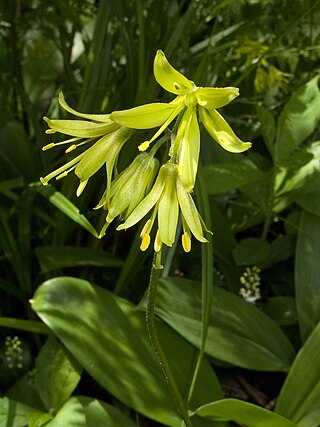
Clintonia borealis is a species of flowering plant in the lily family Liliaceae. The specific epithet borealis means "of the north," which alludes to the fact that the species tends to thrive in the boreal forests of eastern Canada and northeastern United States.
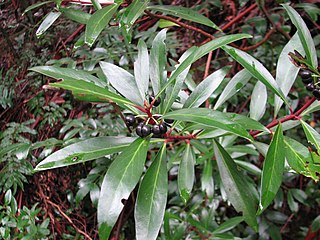
Tasmannia lanceolata, commonly known as Tasmanian pepperberry or mountain pepper, is a shrub native to woodlands and cool temperate rainforest of south-eastern Australia. The shrub varies from 2–10 metres (6.6–32.8 ft) high. The aromatic leaves are lanceolate to narrow-elliptic or oblanceolate, 4–12 cm long, and 0.7–2.0 cm wide, with a distinctly pale undersurface. Stems are quite red in colour. The small cream or white flowers appear in summer and are followed by black, globose, two-lobed berries 5–8 mm wide, which appear in autumn. There are separate male and female plants.

Cypripedium acaule is a species of flowering plant in the orchid family Orchidaceae native to eastern North America. It is the provincial flower of Prince Edward Island, Canada, and the state wildflower of New Hampshire, United States.

Selaginella lepidophylla is a species of desert plant in the spikemoss family (Selaginellaceae). Known as a "resurrection plant", S. lepidophylla is renowned for its ability to survive almost complete desiccation. Resurrection plants are vascular rooted plants capable of surviving extreme desiccation, then resuming normal metabolic activity upon rehydration. The plant's hydro-responsive movements are governed by stem moisture content, tissue properties and a graded distribution of lignified cells affecting concentric stem stiffness and spiraling. During dry weather in its native habitat, its stems curl into a tight ball, uncurling only when exposed to moisture.

Heritiera littoralis, commonly known as the looking-glass mangrove or tulip mangrove, is a mangrove tree in the family Malvaceae native to coastal areas of eastern Africa, Asia, Melanesia and northern Australia. The common name refers to the silvery appearance of the underside of the leaves, resembling a mirror to some degree. The strong timber has uses in marine applications and elsewhere.

Symphyotrichum lateriflorum is a species of flowering plant in the aster family (Asteraceae). Commonly known as calico aster, starved aster, and white woodland aster, it is native to eastern and central North America. It is a perennial and herbaceous plant that may reach heights up to 120 centimeters and widths up to 30 centimeters.

Gazania rigens, sometimes called treasure flower, is a species of flowering plant in the family Asteraceae, native to coastal areas of southern Africa. It is naturalised elsewhere and is widely cultivated as an ornamental plant.

In botany, succulent plants, also known as succulents, are plants with parts that are thickened, fleshy, and engorged, usually to retain water in arid climates or soil conditions. The word succulent comes from the Latin word sucus, meaning "juice" or "sap".
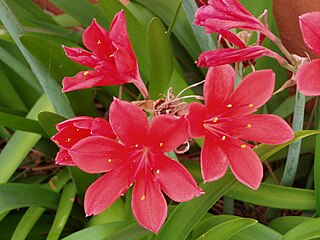
Cyrtanthus is a genus of perennial, herbaceous and bulbous plants in the family Amaryllidaceae, subfamily Amaryllidoideae.

Solidago gigantea is a North American plant species in the family Asteraceae. Its common names include tall goldenrod and giant goldenrod, among others.
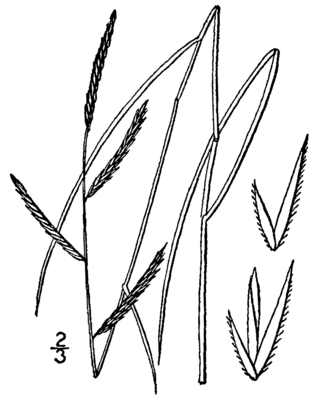
Sporobolus pumilus, the saltmeadow cordgrass, also known as salt hay, is a species of cordgrass native to the Atlantic coast of the Americas, from Newfoundland south along the eastern United States to the Caribbean and north-eastern Mexico. It was reclassified after a taxonomic revision in 2014, but the older name, Spartina patens, may still be found in use. It can be found in marshlands in other areas of the world as an introduced species and often a harmful noxious weed or invasive species.
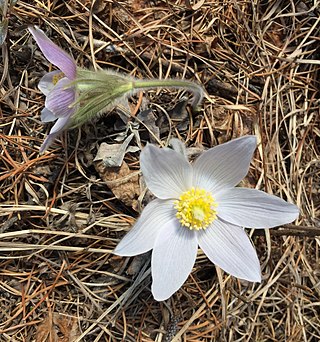
Pulsatilla nuttalliana, known as American pasqueflower, prairie pasqueflower, prairie crocus, or simply pasqueflower, is a flowering plant native to much of North America, from the western side of Lake Michigan, to northern Canada in the Northwest Territories, south to New Mexico in the southwestern United States. Pasqueflower is the provincial flower of Manitoba and the state flower of South Dakota.

Vaccinium pallidum is a species of flowering plant in the heath family known by the common names hillside blueberry, Blue Ridge blueberry, late lowbush blueberry, and early lowbush blueberry. It is native to central Canada (Ontario) and the central and eastern United States plus the Ozarks of Missouri, Arkansas, southeastern Kansas and eastern Oklahoma.

Urtica gracilis, commonly known as the slender nettle, tall nettle, or American stinging nettle, is a perennial plant plant without woody stems that is well known for the unpleasant stinging hairs on its leaves and stems. It is native to much of the North America from Guatemala northwards and temperate areas of South America. It is easily confused with the visually very similar Eurasian species Urtica dioica and is still listed in some resources as a subspecies of this plant. However, genetic analysis and experiments show that they are genetically distinct.



















